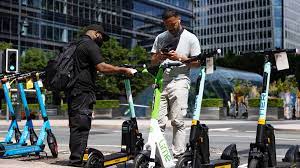Sustainable Transportation: How Segway Contribute to a Greener City

Segway is a manufacturing company that makes two-wheeled personal transport systems and robotics.
It is an American company established in 1999 by acclaimed inventor Dean Kamen and introduced its first product, the Segway PT, to consumers near the end of 2001.
Segway’s initial target was a revolution in personal transportation, but the firm encountered problems in sales and prospects of safety as well as regulation.
There was a pass of hands between British millionaire Jimi Heselden, who acquired them in 2009 but subsequently passed away, then 2013 Segway was purchased by Summit Strategic Investments, then another passing of the torch to Ninebot who are significant player in the market who saw the niche in the market and boost the company to where it is in 2024. .
Throughout the years, Segway Inc. has built its brand through product diversification and market expansion, as well as collaborating with other firms in related or different industries.
Some of the milestones and achievements of Segway’s brand development are:
- The firm made an alliance with General Motors in 2009 to create a two-seat vehicle prototype called ‘Project PUMA’.
- Segway introduced its first three-wheel personal transporter for the public safety market, called the SE-3 Patroller Generator, in 2014.
- For the consumer market, Segway released Ninebot by Segway miniPRO in 2015, a smaller and lighter self-balancing scooter.
- Segway has already created the Segway Robotics division in 2017, which was established to develop personal robots based on their technology and distribute them across different regions all over the world.
- At the Consumer Electronics Show 2018, Segway launched its first product from the e-Skates category, known as the Segway Drift W1 and a self-balanced wheelchair called the S-Pod.
- At the EICMA show in 2019, Segway unveiled two models – Segway-Ninebot MAX (a long-range electric scooter) and Dirt eBike by Segway (an electric off-road motorcycle).
- Segway also launched the Segway Apex, an electric sports motorcycle. Some months later, at the same Consumer Electronics Show, it released its self-balancing wheelchair known as The S-Pod.
Contents [show]
Contributions of Segway towards Greener City Life
Regarding environmental sustainability, Segway offers personal transportation using electric materials and service robots that help reduce carbon footprints while conserving energy and availing congestion-free urban areas.
The products offered by Segway work on a self-balancing technology, offering greater efficiency and stability over other vehicles.
Segway also use:
- LED Lights
- Regenerative Braking
- Plus, Recyclable Materials that help promote environmental friendliness…
The products that Segway designs and manufactures can serve different purposes, including:
- Commuter Transport
- Delivery Services Vehicles
- Plus, Entertainment
This also allows Segway products to be incorporated into smart city platforms – 5G, AI, and IoT– adding intelligence into its systems and networking.
These are products that can allow all city users to live in a greener, smarter and more secure environment.
Segway’s Move Towards Carbon Neutrality
- All products that Segway manufactures are electric types; hence no greenhouse gas or air pollutants, which is the main focus to lower globally.
- What is interesting about Segway’s products is that they apply regenerative braking. Thus, the energy that has been lost during braking can actually be recovered by transforming it into electricity.
- It has LED lights built into its products; these take less power to light up and also last longer than traditional bulbs.
- One of the characteristics is low environmental impact and waste disposal as they are manufactured using recyclable materials such as polypropylene and aluminium alloy.
- The usage lifetime of Segway’s products is long, and this means that the number of replacements and disposals is reduced.
Predictions and Expectations for Segway
Segway will forge ahead with fresh take-to-market products as the likes of Segway Apex H2, a power source hydrogen-fuelled electric motorbike and Seaway S-Pod – an automatic self-balancing wheelchair that will cater for niche markets & customers.
- Segway will enter new markets emerging for its personal electric transportation solutions in the Asia Pacific, Latin America, Middle East and Africa.
- By inking the partnership deal, Segway will influence more resources and technologies as well as accessible consumers through Ninebot, which is known worldwide for being the biggest shareholder of Segway – this will propel its brand worth.
- Segway will need to overcome a range of challenges and risks, including safety questions, regulatory obstacles or acceptance test difficulties, and environmental criticism problems related to cyber-security, which, with their new acquisitions and their market standing, they will deal with proactively this decade and the way their momentum has shifted from the early days, they look in very good shape.
SUMMARY
Being a company in the sector they are in, their brand name is well-known, and customers are very loyal to it. Even now, Segway provides niche products that are safe and durable for police departments, military units and many more corporations around the world, plus large-scale industrial use. They are also committed to ensuring that their products are accessible and affordable so that their target market that benefits from some of their creations is the average person looking for a solution. One of the great comeback stories is in full effect!





